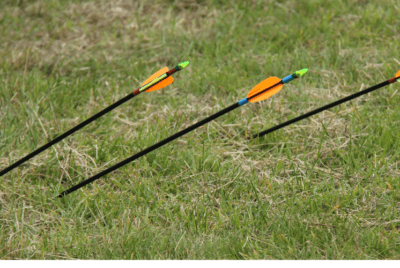How to Make a Bow and Arrow: A Beginner’s Guide to Crafting Your Own Archery Equipment
"We may earn a commission for purchases made using our links. Please see our disclaimer to learn more."
There’s nothing quite like the satisfaction of shooting a perfectly crafted bow and arrow that you made with your own hands. Not only does it offer a sense of accomplishment, but it also allows you to tailor the equipment to your specific needs and preferences. In this article, I will guide you through the process of making a bow and arrow, providing helpful suggestions and reasons for each step. So, let’s dive in and unlock the art of bow making!
Understanding the Basics of Archery
Before we delve into the intricacies of crafting a bow and arrow, it’s essential to understand the importance of a well-made set of archery equipment. A high-quality bow and arrow are the foundation of accurate and consistent shots. It’s crucial to familiarize yourself with the different types of bows available in archery, such as longbows, recurve bows, and compound bows, to determine which one aligns best with your archery goals and preferences. Once you’ve chosen the bow type, selecting the right materials becomes the next vital step.
Choosing the Right Materials
When it comes to crafting a bow, selecting the appropriate materials significantly impacts its performance and durability. The most common materials used for making bows are wood, fiberglass, and carbon fiber. Each material has its unique characteristics and benefits, and the choice depends on factors such as experience level, desired bow design, and personal preference. For beginners, wood is often an excellent choice due to its availability, affordability, and ease of working with. A great wood choice to use is a Hickory bow kit which will provide a perfect start to crafting your custom bow.
Step-by-Step Guide to Making a Bow
Now that we have a good grasp of the fundamentals, let’s dive into the step-by-step process of making your own bow. To ensure a smooth experience, gather the necessary tools and materials, including a stave of your chosen wood, a draw knife, a rasp, sandpaper, and a tillering string. These tools will enable you to shape and refine your bow stave effectively.
With the tools in hand, it’s time to select the bow design that aligns with your goals and skill level. Popular designs include the longbow, recurve bow, and self-bow. Each design has its unique characteristics, such as simplicity, power, or maneuverability. Consider your shooting style and preferences when making this decision.
Once you’ve chosen your design, carefully shape the bow stave using a draw knife, rasp, and sandpaper. This process requires precision and patience, as you gradually remove excess wood to create the desired shape and thickness. Pay close attention to maintaining symmetry and smooth curves along the entire length of the bow.
After shaping the bow stave, it’s time to tiller the bow. Tillering involves carefully bending the bow to ensure even distribution of stress when drawn. This step is crucial for achieving optimal performance and preventing any potential issues like limb twisting or breakage. Use a tillering string to assess the bend and make adjustments as needed, gradually working towards a balanced and efficient bow.
Once you’re satisfied with the tillering, it’s time to apply finishing touches to your bow. Sand the entire surface to smooth out any rough areas and ensure a comfortable grip. You can also choose to stain or varnish the bow to enhance its appearance and protect it from moisture and wear.
Crafting the Perfect Arrows
While the bow is the centerpiece of archery, arrows play a vital role in accurate shooting. Crafting your own arrows allows you to customize factors like weight, length, and fletching to suit your shooting style. Begin by selecting arrow shaft materials such as wood, aluminum, or carbon fiber. Each material has its pros and cons in terms of durability, weight, and performance.
Next, attach fletchings, which are the feather or plastic vanes that stabilize the arrow during flight. Fletchings ensure proper arrow spin and improve accuracy. Nocking is the process of attaching a nock to the rear end of the arrow, which enables it to be properly aligned and held by the bowstring.
To complete your arrows, install arrowheads. Broadheads are commonly used for hunting, while target points or field points are suitable for target practice. Ensure the arrowhead is securely attached to the shaft, and make any necessary adjustments to achieve the desired weight and balance.
Fine-Tuning and Testing Your Bow and Arrow
Once you’ve crafted your bow and arrows, it’s crucial to fine-tune and test them for optimal performance. Start by adjusting the brace height, which is the distance between the bowstring and the grip when the bow is unstrung. Experiment with different brace heights to find the one that provides the best combination of power and accuracy for your specific bow.
Next, determine the optimal draw weight for your bow. The draw weight refers to the force required to pull the bowstring to its full draw. It’s important to find a draw weight that suits your strength and shooting style. Remember, starting with a lower draw weight allows you to develop proper form and technique before gradually increasing the weight as you progress.
To ensure proper arrow flight, make sure the arrows are spine matched to the bow. Arrow spine refers to the stiffness of the arrow shaft, and matching it to the bow’s draw weight and arrow length is crucial for consistent and accurate shots. Test different arrows and spine configurations to find the combination that yields the best results.
Maintenance and Safety Tips
To prolong the lifespan of your bow and arrows, regular maintenance is essential. Inspect your equipment regularly for any signs of damage or wear. If you notice any cracks, splintering, or fraying, take immediate steps to repair or replace the affected parts. Proper storage and transportation are also crucial to prevent any accidental damage. Invest in a bow case or rack to protect your bow from extreme temperatures, moisture, and physical impact.
Safety should always be a priority in archery. Always follow proper archery range rules and guidelines. Wear protective gear such as an armguard and finger tab or glove to prevent injuries. Practice proper shooting techniques and be aware of your surroundings. Never point an arrow at anything you don’t intend to shoot.
Conclusion
Crafting your own bow and arrow is a fulfilling endeavor that allows you to fully engage with the art of archery. By understanding the importance of a well-made bow and arrow, choosing the right materials, and following a step-by-step process, you can create a personalized set of archery equipment that suits your needs and preferences.
Remember, the process of making a bow and arrow requires patience, precision, and practice. Take your time to shape the bow stave and tiller it properly to achieve optimal performance. Craft your arrows with attention to detail, ensuring the right materials, fletchings, and arrowheads are chosen.
Once your equipment is ready, fine-tune it by adjusting the brace height, finding the optimal draw weight, and matching arrows to your bow. Regular maintenance and safe handling will ensure the longevity of your bow and arrows, as well as keep you safe during your archery journey.
So, embrace the art of bow making and enjoy the rewarding experience of shooting with archery equipment that you crafted with your own hands. Step onto the range with confidence, knowing that your personalized bow and arrow will help you hit your targets with accuracy and precision.
FAQs
1. Is it difficult to make a bow and arrow from scratch?
Crafting a bow and arrow requires some skill and patience, but it is achievable with the right guidance and practice. Starting with simpler designs and materials can make the process more accessible for beginners.
2. What materials are best for bow making?
Common materials used for bow making include wood, fiberglass, and carbon fiber. Each material has its advantages and considerations. Wood is often preferred by beginners due to its availability and ease to work with.
3. Can I customize the design of my bow and arrows?
Absolutely! One of the joys of making your own bow and arrow is the ability to customize them to your liking. You can choose the bow design, materials, and add personal touches to the arrow shafts, fletchings, and arrowheads.
4. How do I ensure the safety of myself and others while practicing archery?
Safety should always be a priority. Follow the rules and guidelines of your archery range or club. Wear protective gear, practice proper shooting techniques, and never point an arrow at anything you don’t intend to shoot.
5. How often should I inspect and maintain my bow and arrows?
Regular inspections are recommended to identify any damage or wear. Depending on your usage, monthly inspections should suffice. Additionally, store your equipment properly and protect it from extreme temperatures, moisture, and physical impact.





